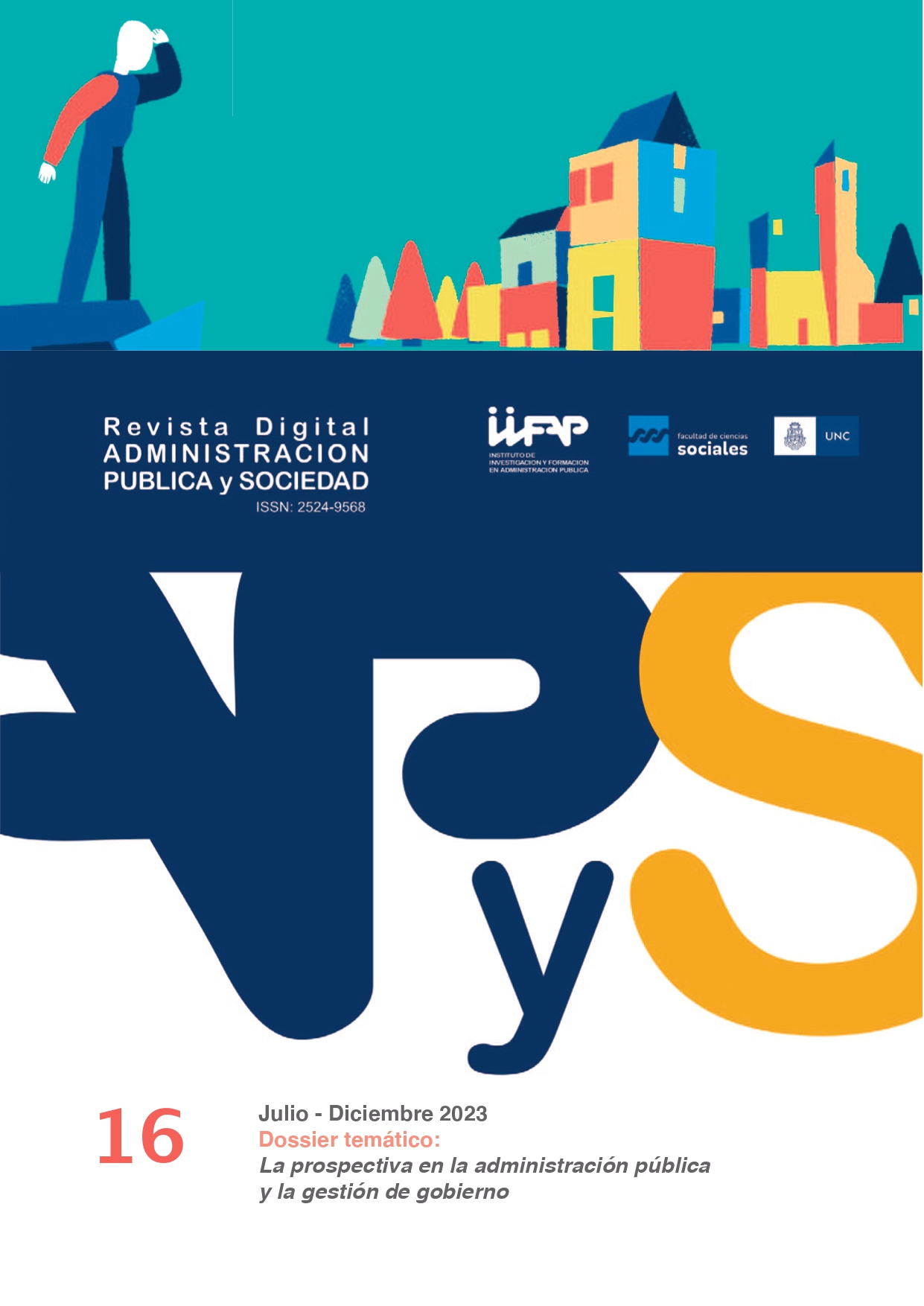Public strategy for the promotion of technified irrigation in Argentina. Future scenarios, plannig and public policies
Main Article Content
Abstract
Argentina specialises in agri-food production and exports. And although it has favourable agro-ecological conditions due to its soils and rainfall in the Central and Mesopotamia regions, two thirds of its territory is arid or semi-arid (in the West and South). At the same time, the phenomena of climate variability and climate change affect production even in humid or semi-humid areas. This paper seeks to provide a prospective view on the adoption of technified irrigation through different types of infrastructure and equipment to better cope with climatic phenomena and at the same time enhance agro-industrial production.
There are historical experiences, institutional antecedents and current policies on technified irrigation in Argentina. It is less common to find in the literature a comprehensive conceptual framework that addresses the different factors that influence its diffusion and that integrates in the analysis policy proposals on the different types of irrigation, whether comprehensive for dry areas or complementary for humid areas.
The work is based on the analysis of the key factors that influence the adoption of technified irrigation in Argentina, constructs three future scenarios and estimates the potential impact on employment, production and exports of the desirable scenario that is identified with a federal planning strategy on irrigation. To this end, the analysis of past and future scenarios has been used to estimate the potential impact on employment, production and exports.
Article Details

This work is licensed under a Creative Commons Attribution-NonCommercial-ShareAlike 4.0 International License.
Authors who publish in this journal accept the following terms of the copyright policy:
- Authors shall retain their copyright (including copyrights) and shall grant to the journal the right of first publication of their work, which shall simultaneously be subject to the Creative Commons Recognition License: No commercial use of the original work or any derivative works is permitted, distribution of which must be made under a license equal to that which governs the original work.
- Authors may adopt other non-exclusive license agreements for the distribution of the version of the published work (e.g., placing it in an institutional repository or publishing it in a book) provided that the initial publication in this journal is indicated.
- Authors are allowed and encouraged to disseminate their work through the Internet (e.g., in institutional repositories or on their website) after the publication process, which may lead to interesting exchanges and increased citations of the published work. (See The Effect of Open Access).
How to Cite
References
BARBERIS, Noelia (2023). “Resultados económicos en cultivos extensivos con riego vs secano”. Departamento de Economía EEA Manfredi. Córdoba,18 mayo (paper).
CANITROT, Adolfo (1983). “El salario real y la restricción externa de la economía”. Desarrollo Económico Vol. 23 No 91.
CEI (Centro de Economía Internacional). (2022). “Pacto Verde Europeo: consecuencias económicas y comerciales”. Artículo. Ministerio de Relaciones Exteriores, Comercio Internacional y Culto. https://cancilleria.geob.ar/userfiles/ut/informe_pacto_verde_europeo-diciembre_2022-articulo.pdf
CHAMBOULERON, Jorge y MORÁBITO, José A. (2005). “El riego en Argentina”. Congreso del Instituto Nacional del Agua. https://www.ina.gov.ar/archivos/publicaciones/INA-Cra-El_riego_en_Argentina.pdf
DIAMAND, Marcelo (1972). “La estructura productiva desequilibrada. Argentina y el tipo de cambio”. Desarrollo Económico. Vol. 12, No 45.
DIAZ ALEJANDRO, Carlos (1963). “A note on the impact of devaluation and the redistributive impact”. Journal of Political Economy. Vol. 71, No 6 (diciembre), pp. 577- 588.
FAO (2015). “Estudio del potencial de ampliación del riego en Argentina”. UTF/ARG/017/ARG Desarrollo institucional para la inversión. https://www.fao.org/fileadmin/user_upload/rlc/utf017arg/estudio/Estudio_del_Potencial_de_Ampliacion_de_riego_en_Argentina.pdf
MINISTERIO DE ECONOMÍA (2022). “Cadenas Productivas Argentinas”. Secretaría de Política Económica, Subsecretaría de Programación Regional y Sectorial. https://www.argentina.gob.ar/sites/default/files/cadenasproductivasargentinas_trabajomadre_mayo2022.pdf
OCDE/FAO (2022). “Perspectivas Agrícolas 2022 2031”. OECD Publishing, Paris. https://doi.org/10.1787/820ef1bb-es
ONU (2022). “World Population Prospects 2022”. Department of Economic and Social Affairs, Population Division. https://population.un.org/wpp/Download/Standard/MostUsed/
PATROUILLEAU, María M.; ANASTASIO, Mario D.; LE COQ, Jean. F.; SOTOMAYOR, Octavio. (2023) “Escenarios agroalimentarios para América Latina y el Caribe”, Buenos Aires: Editorial Teseo https://www.teseopress.com/escenariosagroalimentariosparaamericaloatinayelcaribe
SAMANIEGO, José L. y SCHNEIDER, Heloísa (2023) “Quinto informe sobre financiamiento climático en América Latina y el Caribe, 2013-2020”. Documentos de Proyectos (LC/TS.2023/85). Comisión Económica para América Latina y el Caribe (CEPAL).
SECRETARÍA DE AMBIENTE Y DESARROLLO SUSTENTABLE DE LA NACIÓN (SAyDS) (2015). “Tercera Comunicación Nacional de la República Argentina a la Convención Marco de las Naciones Unidas para el Cambio Climático (CMNUCC)”. https://unfccc.int/documents/67499
UNITED STATES AGRICULTURAL DEPARTMENT (USDA) (2023). “USDA Agricultural Projections to 2032”. Interagency Agricultural Projections Committee https://www.ers.usda.gov/webdocs/outlooks/105853/oce-2023-01.pdf?v=3515.9
VAN DIJK, Michiel, MORLEY, Tom, RAU, Marie L. y SAGHAI, Yashar (2021). “A meta-analysis of projected global food demand and population at risk of hunger for the period 2010–2050”, Nat Food, 2, pp. 494–501. https://doi.org/10.1038/s43016-021-00322-9
Otras fuentes de datos:
DIU (Departamento de Información Universitaria). Base de datos. https://guiadecarreras.siu.edu.ar/carreras_de_posgrado.php
DIPROSE (Dirección de Programas y Proyectos Sectoriales y Especiales), (s.f.) “Programas y proyectos”. https://www.argentina.gob.ar/economia/planificacion-del-desarrollo-y-la-competitividad-federal/programas-y-proyectos
INDEC (Instituto Nacional de Estadísticas y Censos). Procesamiento especial de datos del Censo Nacional Agropecuario 2018.
ONU. Base de datos de Naciones Unidas en Comercio Internacional: https://comtradeplus.un.org/

